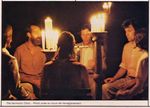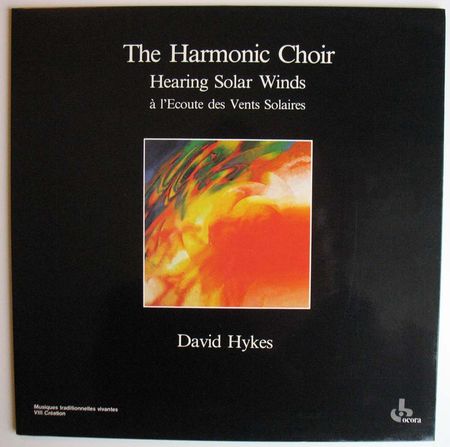David Hykes - The Harmonic Choir, Hearing Solar Winds, Coll. Ocora, Lp, 1980
The Harmonic choir was formed by David Hykes in 1975. An accomplished experimental filmmaker with a deep interest in traditional and sacred music, David Hykes had already acquired broad familiarity with the music of West and Central Asia when he first heard of the Hoomi singing (literally "throat singing") indigenous to western Mongolia, and the overtone chanting of Tantric Tibetan Buddhism.
In the Hoomi tradition, singers produce a fundamental tone in the bass or baritone range, and then by extemely precise modulation of the abdominal muscles, chest, and vocal apparatus - larynx, tongue, jaws, cheeks and lips - project simultaneously a higher tone or tones, related in frequency to the fundamental tone by whole number ratios. These higher frequencies are called "overtones" or "harmonics". In producing harmonics, the voices acts like a kind of sonic prism, "refracting" sound along a frequency spectrum wich extends upwards from the fundamental tone.
Each fundamental tone has potentially infinite harmonics. For any starting frequency, which can be called "one", the first overtone or second harmonic (the two are identical) is "two", or twice the rate of vibration of "one". The third harmonic, or "three", is three times the frequency of "one", and so on. In the Choir's music, harmonics are used in several different ways. First, harmonics which range from 5 to 15 times the frequency of a fundamental tone may be joined together to produce high flute-like melodies of the sort heard in Parts I an VI of "Hearing Solar Winds". Second, lower harmonics - "two", "three", "four" and "five"- are projected from a cluster of fundamental notes, creating a tones, as in part II. Third, harmonics may be transposed down from their own octave into the harmonic void between "one" or "two" where as fundamental tones, they are used to construct sustained chords and contrapuntal polyphonies. The tuning of the entire system thus reflects the whole number "Pythegorean" frequency ratio intrinsic to the harmonic serie.
Hykes' music has diverged in several important respects from that of Mongolian and Tibetans who inspired him. Most significant is his identification and active manipulation of five different levels of "harmonic music", as follow :
music has diverged in several important respects from that of Mongolian and Tibetans who inspired him. Most significant is his identification and active manipulation of five different levels of "harmonic music", as follow :
Level 1 : The singer holds a steady fundamental note and a steady harmonics, as in Tibetan sacred chant.
Level 2 : The singer moves the fundamental note melodically and the harmonic moves in parallel with it, as found en passant in some western sacred chant, i.e. Bulgarian chant, organum.
Level 3 : The singer holds a steady fundamental note and creates melodies with the harmonics as in Mogolian Hoomi singing.
Level 4 : The singer holds a harmonic steady and moves the fundamental note.
Level 5 : The singermoves both the harmonics and teh fundamental note.
Liner notes by Théodore Levin
DOWNLOAD Warning : you are donwloading a zip folder wich contains pics from the Lp version and mp3 from the Cd version, this music does not deserve scratch nor stitch.





/http%3A%2F%2Fstorage.canalblog.com%2F07%2F61%2F656353%2F68402008_o.jpg)
/http%3A%2F%2Fstorage.canalblog.com%2F25%2F11%2F656353%2F65831793_o.jpg)
/http%3A%2F%2Fstorage.canalblog.com%2F76%2F85%2F656353%2F91010578_o.jpg)
/https%3A%2F%2Fassets.over-blog.com%2Ft%2Fcedistic%2Fcamera.png)